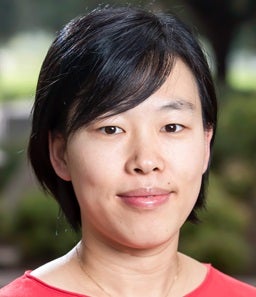The Mathematics Department proudly announces that Professor Weitao Chen is the winner of the National Science Foundation CAREER Award on Multiscale Model for Cell Morphogenesis and Tissue Development in Plant Leaves.
The proposed study will improve our understanding about general mechanisms involved in cell morphogenesis. Epidermal cells in plant leaves, especially pavement cells (PCs), exhibit interdigitated puzzle shapes. Shape formation of PCs serves as an ideal model to understand principles governing cell morphogenesis and tissue growth in developmental biology. During the development, PCs change from small rounded polygonal shapes into large interdigitated puzzle shapes, under the regulation of the extracellular plant hormone and multiple key molecules accumulated at the plasma membrane (PM). This developmental process also involves reorganization of cytoskeletal components and dynamic cell-to-cell communication. The multiscale mathematical model proposed in this research will have a broad range of applications from tissue engineering to biomanufacturing and biotechnology. The PI will develop a satellite undergraduate research program based on University of California, Riverside (UCR), a Hispanic-serving institution with many first generation college students. The program will also recruit students from California State Universities and high schools in local public school district. Research symposia and summer research programs will be organized through coordination with the department of mathematics, Association of Women in Mathematics at UCR Chapter, Interdisciplinary Center for Quantitative Modeling in Biology at UCR, and nearby colleges to promote public awareness on research and career paths in mathematical biology.
The morphogenesis of PCs is a complex process. During the early stage, extracellular hormone induces nanoclustering on the PM of individual cells to initiate cell polarization. It is followed by nonhomogeneous mechanical forces exerted along the cell wall and a subcellular signaling gradient to regulate cell-cell interaction. Stable cell polarization, further the interdigitated jigsaw cell shapes, will be established under the regulations between the nanoclustering signals and structural components in the same cell and regulations of Rho GTPase signals between neighboring cells. Different hypotheses have been proposed for the mechanism underlying the PC morphogenesis, while most of them focus on either chemical signals or mechanical properties in PCs. The proposed study will test new hypotheses that include both the chemical signaling network and mechanical properties, as well as interactions between them, and therefore provide novel insights into the fundamental principles of cell shape formation and tissue development. This project will develop a multiscale model using the local level set method to incorporate both chemical signals and mechanical properties in a multicellular environment to test different hypotheses on the shape formation of PCs. Machine learning techniques and experimental data will be used in the modeling selection, parameter estimation and model calibration.
